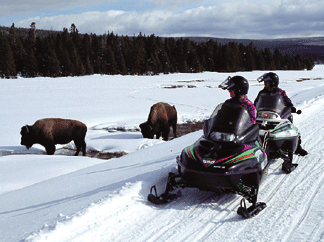Yellowstone snowmobile plan finally getting off its merry-go-round?
Effects of Noise on Wildlife, Human impacts, News, Vehicles, Wildlands Add commentsIt’s been a couple of years since we’ve checked in on the eternal Snowmobiles in Yellowstone debate, and in what’s sure to be a shock for those who’ve been following the issue since the Clinton administration, not much has changed! During Team Obama’s first summer, Ken Salazar announced that the ongoing string of temporary winter use plans would be extended for a couple of years while the NPS accepted comments on yet another round of EIS preparation. The Clinton adminstration completed an full EIS process, and announced its final ruling (which banned snowmobiles) just in time for the winter during which W was sworn in; the Bush NPS team suspended that plan and launched a brand new round of comments under a new set of temporary rules. While the Bush plan didn’t ban snowmobiles, it did require, for the first time, that all groups of snowmobilers go with a local professional guide. This requirement led to a dramatic decrease in snowmobiles entering Yellowstone; most snowmobilers prefer being able to be footloose, and the huge expanses of National Forest land in the region became their preferred playground. Complicating implementation of that plan, however, were dueling Federal court rulings that appeared to contradict each other; some of these uncertainties lingered on into 2009, as the Obama administration began overseeing the process.
 In the years since, the two-year extension of the Bush-era temporary plan stretched to four, and finally the new proposed plan has been released. In truth, it isn’t all that different than the Bush plan in terms of total numbers of snowmobiles and snowcoaches, though it tweaks a few elements in ways that may reduce some impacts, especially air quality, over time. It seems likely that the noise impacts will be roughly similar to those documented in a series of studies we covered here in 2009, in which NPS researchers found that snowmobiles or snowcoaches were audible over half the day in many popular areas, including at Old Faithful 68% of the time, and 59% of the time at Madison Junction. Still, the new plan does include some absolute dB limits for snowmobiles (67dB) and snowcoaches (75dB), and requires best-available technology on all vehicles by five years from now. The plan opens the door a crack to unguided groups (allowing one per day from each Park entrance), and continues the expensive practice of using explosives to keep a rarely-used pass open to snowmobiles (at the behest of the businesses in nearby Cody, Wyoming). While the plan slightly increases the average number of snowmobiles to be allowed (from 318 to 342), the actual daily average over the past several winters has been under 200 per day.
In the years since, the two-year extension of the Bush-era temporary plan stretched to four, and finally the new proposed plan has been released. In truth, it isn’t all that different than the Bush plan in terms of total numbers of snowmobiles and snowcoaches, though it tweaks a few elements in ways that may reduce some impacts, especially air quality, over time. It seems likely that the noise impacts will be roughly similar to those documented in a series of studies we covered here in 2009, in which NPS researchers found that snowmobiles or snowcoaches were audible over half the day in many popular areas, including at Old Faithful 68% of the time, and 59% of the time at Madison Junction. Still, the new plan does include some absolute dB limits for snowmobiles (67dB) and snowcoaches (75dB), and requires best-available technology on all vehicles by five years from now. The plan opens the door a crack to unguided groups (allowing one per day from each Park entrance), and continues the expensive practice of using explosives to keep a rarely-used pass open to snowmobiles (at the behest of the businesses in nearby Cody, Wyoming). While the plan slightly increases the average number of snowmobiles to be allowed (from 318 to 342), the actual daily average over the past several winters has been under 200 per day.
Given that previous plans have triggered lawsuits from both environmental groups seeking stricter rules and local business interests wanting fewer restrictions, it’s probably a good sign that both the Greater Yellowstone Coalition and the snowmobile group Blue Ribbon Coalition responded with generally positive comments, while unlike 2009, no instant legal challenge came from the State of Wyoming, either. Fatigue has finally settled in, it appears, as the BRC’s spokesman suggested: “I think for my organization it would be important to resolve this and come up with a long-range plan that doesn’t get challenged in the courts.”
For detailed coverage of the new plan, see this article from National Parks Traveller. The local Billings Gazette is always a good source for those wanting to track how this all unfolds.
